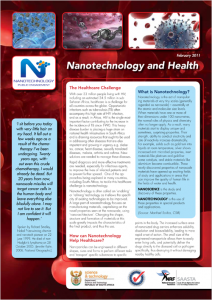These fact sheets have been developed with the purpose of providing factual non-biased information and references on various topics of nanotechnology. Each fact sheet has followed a scientific editorial process and has been reviewed by an independent expert in the field of nanotechnology.
Nanotechnology – Big science with tiny building blocks
“Nanotechnology – Big science with tiny building blocks” gives an introduction to nanotechnology, explaining what nanotechnology is, what its past and potential future and hopes and hazards of nanotechnology.
If you can picture dividing one millimetre into a million equal slices, you’re at the infinitely miniscule scale of atoms and molecules. Scientists have discovered that materials behave very differently when they are made up of very small building blocks. Nanotechnology puts these discoveries to work by manipulating the basic building blocks of matter – one atom at a time – to produce unique materials and novel processes…
Nanotechnology – The science of the very small
“Nanotechnology – the science of the very small” also describes what nanotechnology means, it describes what nanotechnology products are available and what risks may arise from nanotechnology and why there is a need for regulations.
Nanotechnology is the study, use, manipulation and creation of materials, devices and systems at very tiny scales – essentially at the atomic and molecular size levels. At this “nanoscale”, the normal rules of physics and chemistry often no longer apply, and as a result, many materials start to display novel, and sometimes, surprising properties, which can be exploited…
Nanotechnology and energy
“Nanotechnology and energy” describes some of the ways nanotechnology may be applied in the energy sector, in producing, conserving and consuming energy. It looks at the potential impact nanotechnology may have in alternative energy solutions, such as solar power and hydrogen and fuel cell technology.
The link between human activities, increased greenhouse gas (GHG) emissions and climate change was scientifically confirmed and agreed internationally in 2007. Since then, efforts to identify alternative energy sources have been heightened due to dwindling fossil fuels, and an anticipated increase in the demand for energy of more than 50% by 2025.
Nanotechnology and health
“Nanotechnology and health” describes potential applications of nanotechnology in the fields of health and medicine. It describes some of the research that is currently underway that may provide new and more effective ways of treating, diagnosing and preventing disease.
With over 33 million people living with HIV, including an estimated 24.5 million in sub-Saharan Africa, healthcare is a challenge for all countries across the globe. Opportunistic infections such as tuberculosis (TB) often accompany this high rate of HIV infection, and as a result, in Africa, HIV is the single most important factor contributing to the increase in the incidence of TB since 1990…
Nanotechnology and water
“Nanotechnology and water” looks at applications nanotechnology may have in the Water sector and in improving the accessibility of clean and safe drinking water, a global concern.
Recent statistics indicate that more people are dying from unsafe water annually than from all forms of violence combined, including war. Providing access to clean water is a priority worldwide. In South Africa, an estimated 5.7 million people lack access to basic water services and about 17–18 million lack basic sanitation services…





